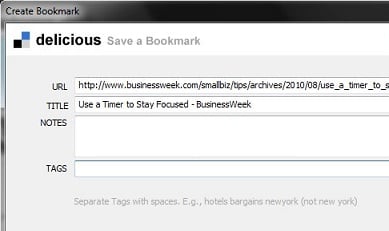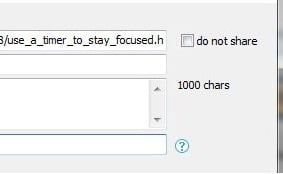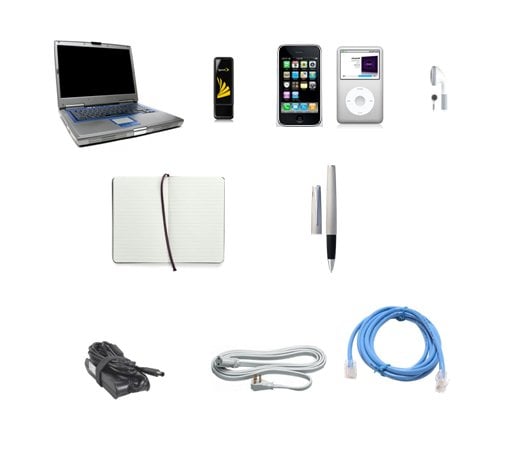While these two strategies apply to a broad range of situations, in this case, I would like to apply them to a specific situation first. Let me start by describing the situation, and then go through the two strategies.
The situation
 Last week, Jenny Blake and I started the Inbox Freedom Webinar Series with a big goal in mind! The goal is to help our participants re-assess behaviors and attitudes toward their e-mail inbox through a series of tips, demonstrations, and interactive exercises, and therefore learn new practices to transform the way they look at email and manage e-mail. We want to transform e-mail from ad-hoc, inefficient, and anxiety-producing to structured, effective and anxiety-free.
Last week, Jenny Blake and I started the Inbox Freedom Webinar Series with a big goal in mind! The goal is to help our participants re-assess behaviors and attitudes toward their e-mail inbox through a series of tips, demonstrations, and interactive exercises, and therefore learn new practices to transform the way they look at email and manage e-mail. We want to transform e-mail from ad-hoc, inefficient, and anxiety-producing to structured, effective and anxiety-free.
This is a big goal indeed! Appreciating its magnitude and potential rewards, we structured the Inbox Freedom program in the form of four sessions spread over four weeks to allow the participants to practice in between sessions. Changing mindsets and behaviors doesn’t happen overnight! The Inbox Freedom webinar first session, which took place last week, was mostly geared towards creating awareness about our current perceptions and habits around our email inbox. After all, awareness is the first step in making meaningful improvements. At the end of the session, Jenny summarized the action items that our participants were to engage in before the next session in order to create this awareness and practice the techniques that we described.
Let us assume you are one of our webinar participants and ask you the question: “Have you implemented the steps that Jenny suggested at the end of the session, or not, or to what degree?” If you have, congratulations! And if you haven’t, or if you tried but then stopped too soon, it is likely that you have encountered an obstacle.
Putting aside the tactical and operational obstacles for now, I am mostly referring to and concerned about a different kind of obstacle. This obstacle is very subtle and yet very powerful; sometimes obvious but most of the time transparent. What I am referring to is YOUR OWN THOUGHTS such as:
- This won’t work (or this won’t work for me—it may work for others but not me)
- I started to work on it, but I didn’t get too far
- This would take too much time and I don’t have the time
- Etc.
The Strategies
Two strategies for helping you do the things you know you want to do:
1. Identify and dispute these thoughts
Dr. Albert Ellis uses the word “dispute” to refer to the act of questioning and challenging these thoughts which he calls “irrational beliefs.” In other words, we need to talk back at these thoughts to uncover the deceptions in them and replace them by “rational beliefs” that are more realistic and more productive. Dr. David Burns explains that there are several common distortions in such thoughts and that if we identify these distortions specifically, we are likely to be successful at dismantling these thoughts.
One of the popular distortions is “predicting the future” which Dr. Burns also refers to as “fortune telling.” It seems to be an art that we are all skilled at. “This won’t work” is exactly that: Predicting the future. “this won’t work” has nothing to do with reality. It is just a thought about the future mostly based on our own assumptions and interpretations and tinted by our biases and past experiences. If we replace this thought by something less distorted and more realistic such as “I can see that this is not easy, but I would like to know if this would work.”
Another popular distortion is the “all-or-nothing” distortion. All-or-nothing transforms the world into a binary world (made up of 0’s and 1’s) which may be true for the digital world but not for life as a whole. “I started to work on it, but I didn’t get too far” might fall into this category. How far did you get? Did you get some results or absolutely no results? How much time did you spend on it? What were you expecting? Did your expectations get in the way? These are just a few ways to dispute this distorted thought.
2. Bypass these thoughts
Bypass them and get into the doing. While identifying and disputing the thoughts is an important strategy, getting into action is another powerful strategy that can be done in addition or instead--preferably in addition. Sometimes it is difficult to get into action because of the paralyzing thoughts and therefore disputing them first and identifying the distortions is crucial. But disputing has its limits and it would be difficult to fully dispute and change our mindset without the factual and emotional learning that comes from experimenting.
Now taking this beyond the Inbox Freedom webinar, when you feel hesitant about taking actions and engaging in activities that you know are likely to lead to good outcomes, stop the indecision and hesitation, and identify the underlying thoughts. Then engage in these strategies to move you forward into action and let reality “tell” instead of allowing assumptions and interpretations “rule.”
Join us at the Inbox Freedom Webinar this week
You are invited to join the complimentary Inbox Freedom Webinar Series. Even if you missed session 1, you can still make up for it by viewing the recording on facebook, and register for session 2 now, and start applying and practicting these strategies!
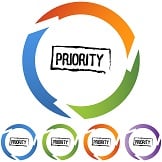 I couldn't have said it any better. "When everything is a priority, nothing is a priority" said my client today as I was shadowing him in order to better understand his organization's work process and tailor our training programs accordingly. Shadowing is such an insightful exercise. It allows us to take a look at what is under the hood; the nuances that make each work environment unique. It is a great learning for everyone involved; the observer, the one being observed, and everyone around them.
I couldn't have said it any better. "When everything is a priority, nothing is a priority" said my client today as I was shadowing him in order to better understand his organization's work process and tailor our training programs accordingly. Shadowing is such an insightful exercise. It allows us to take a look at what is under the hood; the nuances that make each work environment unique. It is a great learning for everyone involved; the observer, the one being observed, and everyone around them.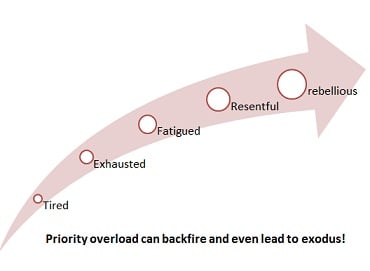


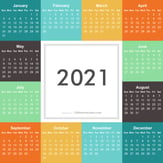





 I belong to this organization (its name to remain anonymous) and it was time to renew my membership recently. I was asked to fill out the membership application again (same application that we filled out last year). Being the productivity and efficiency evangelist that I am, I couldn’t “digest” that request very well. So I objected and questioned why we would be asked to submit the same information again! Shouldn’t we all be focused on doing work that has some purpose after all?
I belong to this organization (its name to remain anonymous) and it was time to renew my membership recently. I was asked to fill out the membership application again (same application that we filled out last year). Being the productivity and efficiency evangelist that I am, I couldn’t “digest” that request very well. So I objected and questioned why we would be asked to submit the same information again! Shouldn’t we all be focused on doing work that has some purpose after all? Last week,
Last week,  My friend Liz said that she realized after a while that no matter how hard she tries to resist having the variety of chocolate treats that are nicely distributed throughout her home, she kept falling for the temptation and having them! What eventually worked for her is to not have chocolate around--in other words, a chocolate-free home! Without getting too deep into the psychological aspects of addictions, let us just keep things simple for now, and extrapolate this techniques to see how it might help with resisting daily interruptions and distractions that keep us getting off track and away from our important initiatives and projects.
My friend Liz said that she realized after a while that no matter how hard she tries to resist having the variety of chocolate treats that are nicely distributed throughout her home, she kept falling for the temptation and having them! What eventually worked for her is to not have chocolate around--in other words, a chocolate-free home! Without getting too deep into the psychological aspects of addictions, let us just keep things simple for now, and extrapolate this techniques to see how it might help with resisting daily interruptions and distractions that keep us getting off track and away from our important initiatives and projects.